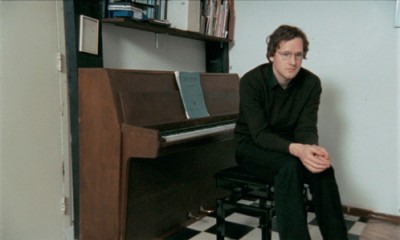TIME AND THE SCORE
19 November 2009
Artists' film and video by Manon de Boer, Lis Rhodes, Mark Aerial Waller, Emily Wardill, and Guido van der Werve.
The final event during the exhibition The Present Moment/The Whole Event is programmed in response to Latham's metaphor of the cosmos as an atemporal omnipresent score, the source of all recurrent action. He used an analogy of a musical score to describe his theory of eventstructure and the universe. The score is always there, as it sits unobserved in a drawer or between the pages of a book, but it only enters our awareness when it is activated as event during performances of it at different moments in time and space.
Guido van der Werve
Nummer zes
Steinway grand piano
Wake me up to go to sleep
And all the colors of the rainbow, 2006
35mm (this film will be screened from DVD)
17'09", colour, sound
Van der Werve sits in his apartment, his glum demeanour and the sparse decor communicating a sense of emptiness within him and his home. He stops on an Amsterdam bridge, contemplating some absent love. He visits a piano sales room to discuss the object of his desire, the Steinway D grand piano, the choice of 99% of the worlds' top pianists, and negotiates hire purchase. In the scenes which follow, the piano is gently lifted and perilously swayed by fork-lift, into the apartment through its third floor window. Accompanied by an orchestra and led by a conductor, van der Werve plays Chopin's Piano Concerto No. 1 in E Minor Op. 11 - 2nd movement 'Romanze', just once.
Emily Wardill
Basking In What Feels Like 'An Ocean Of Grace' I Soon Realise That I'm Not Looking At It, But Rather I Am It, Recognising Myself, 2006
16mm
8 mins, colour, sound (optical)
In Basking in what feels like 'an ocean of grace', I soon realise that I'm not looking at it, but rather that I AM it, recognising myself, instead of taking a symbol that was constructed ideologically then applied to reality, she took the setting of the 'focus group' and used its surface as an example. The participants were speaking, but they became images. Emily Wardill used computer software to compose music that would appear symmetrical when seen laid out as sheet music. The middle of the music, where it began to play inverted, would be the middle of the film that the music was written for. Rhythmical and mathematical to the point of irrationality, the film attempts to become a resistant image in itself. Mocking the idea of representation as a token, as a replacement rather than a tool of involvement, she wanted to ask: "if the object of ideology becomes sublime, what is the relationship of the image to that which is represented?"
But she wanted that question to be an ocean.
This is the first of two films looking at the way in which the personal becomes represented. Exploring the 'focus group' and the 'psychological case study', historically and in the present day, Wardill continues her interest in the exemplary and the symbolic. (LUX, London)
Mark Aerial Waller
The Sons Of Temperance, 2000
Video
7 mins, colour, sound
The Sons of Temperance is a journey into a dark sphere of information retrieval; the search for interpretation.
Mark Aerial Waller's film work is introduced by a man talking about collections of ancient ceramics. In their creation, potters would turn pieces of clay on a wheel. As they were turned, the potter's fingernails or tools created grooves in side the pot, which would resonate with the voices or sounds of what was happening in the vicinity. Today, these ceramic pieces can be played back like vinyl recordings. The collection's value no longer resides in the visual, but in the secret beauty of the audio. "Like Elliot, like Nerval, like anyone obsessed with picking up and incubating what Rilke calls 'The unending message that forms itself from silence', the initiates are finding the knowledge and the isolation just too much to bear."
Tom McCarthy (text from LUX, London)
Manon De Boer
Presto - Perfect Sound, 2006
35mm (this film will be screened on DVD)
6 mins, colour, sound
Manon de Boer's film Presto - Perfect Sound depicts composer and violinist, George Van Dam, performing the fourth movement of a Bartok violin sonata. In order to achieve the 'perfect' soundtrack, de Boer edited together the audio track from the five different recordings with the performer and then edited the film to this soundtrack. In allowing the audio sequence to dictate the image on screen, de Boer inverts the traditional dominance of image over sound in cinema. The film is a meditation on the relationship between sound and image and offers an intense reflection on a moment of creative concentration, when the subject is fully absorbed, almost as if out of sync with the world around him. (LUX, London)
Manon de Boer's Presto - Perfect Sound was co-commissioned by Frieze Projects/LUX
Lis Rhodes
Light Music (Abridged), 1976
16mm
15 mins, b&w, sound (optical)
A compressed, single-screen version of Rhodes' famous fusion of optical sound and image. "Lis Rhodes has conducted a thorough investigation into the relationship between shapes and rhythms of lines and their tonality when printed as sound. Her latest work,Light Music, is in a series of movable sections. The film does not have a rigid pattern of sequences and the final length is variable. The imagery is restricted to lines of horizontal bars across the screen: there is variety in the spacing (frequency), their thickness (amplitude), and their colour and density (tone)." - William Raban, extract from programme notes for Perspectives on British Avant-Garde at Hayward Gallery, 1977. (LUX, London)
With thanks to LUX, London and Galerie Juliette Jongmar, Amsterdam.

Still from Guido van der Werve, Nummer zes/Steinway grand piano/Wake me up to go to sleep/And all the colors of the rainbow (2006) 35mm film. Image courtesy the artist and Galerie Juliette Jongma